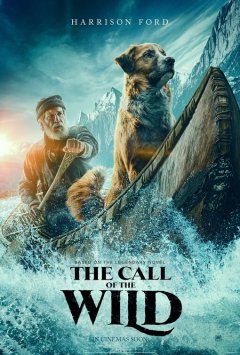
The following is a review of The Call of the Wild (2020) — Directed by Chris Sanders.
Chris Sanders’ The Call of the Wild is an adaptation of the Jack London short adventure novel of the same name from 1903, which, since 1923, has been made into several films. Set in the late 19th Century, the film follows Buck (motion-captured by Terry Notary), a large and excited St. Bernard-Collie dog. In the film’s opening, the oversized, eager, and excited dog from California is abducted, crated, and put on a ship headed for Yukon. In snowy Yukon, Buck is then swiftly sold to become a sled dog, which he struggles with. Over the course of the film, Buck experiences wilderness, he leads by example, and he encounters new masters and friends, including John Thornton (played by Harrison Ford), a grumpy and world-weary nomad, who learns to love man’s best friend.
The Call of the Wild is Chris Sanders’ live-action directorial debut, and the accomplished animation director, who has previously co-directed hits such as Lilo & Stitch, The Croods, and How to Train Your Dragon, has, for his first foray into live-action filmmaking, taken on a project with which he could, sort of, stay within the realm of animation. This is an effects-heavy adaptation of Jack London’s popular adventure novel that doesn’t, however, feel as adventurous, as engaging, or as real as it should. These last couple of years we’ve seen several live-action/animation hybrid remakes that attempt to capture the charm of previous versions of popular stories. Jon Favreau found a lot of success with his version of The Jungle Book, but he fell short with his remake of The Lion King.
Chris Sanders and his team approached this film in a curious way, and, ultimately, I think the decision to pair live-action actors up with a computer-generated and overly expressive version of ‘Buck’ was a mistake. I thought that Buck’s computer-generated almost anthropomorphic appearance was a double-edged sword, so to speak. Sure, on the one hand, the CG-appearance makes it easier to watch the sad and intense scenes as they don’t feel as real or threatening as they could’ve, but, on the flip-side, the computer-generated images also make it more difficult to become emotionally attached to the formulaic narrative.
Though I do applaud the job that the visual effects artists and Terry Notary, the Motion-Capture performer who ‘played’ Buck on set, have done here, the film’s approach is questionable. Although Notary and the VFX artists do occasionally capture the behavior of a dog convincingly (e.g. I loved Buck’s first interaction with snow, as it brought back fond memories for me), the film’s version of Buck becomes so unconvincingly expressive that it looks like he understands every word spoken to him. At some points in the film, I wondered if it would’ve been smarter to just let Buck have a voice and narrate his own actions. Although that may sound cheesy or cheap, I think it would’ve been wiser, as it, one, would’ve worked better than Harrison Ford’s voice-over and, two, it may have let younger audience-members appreciate the film more easily.
The film, which was written by Michael Green, is also tonally inconsistent. I believe this is intended to be a family-friendly film, but there are certain sequences that I’m just not sure will work for younger audiences. There are stretches of the second half of the film that deal with alcohol dependency and grief, which I think will make younger audiences feel exhausted or uninterested, and the film’s most memorable sequence, which focuses on Buck’s attempt to become the leader of a pack of sled dogs, is surprisingly intense and violent. These scenes clash with scenes such as the one where Buck excitedly, and in an exaggerated manner, runs through a house in the film’s opening.
As John Thornton, Harrison Ford walks in the footsteps of Clark Gable, Charlton Heston, and Rutger Hauer, who have all played the character in previous adaptations, and Ford is perfectly believable as this nomad. Ford has one or two scenes wherein he gets to exhibit real emotion, and his performance, which is definitely up to scratch, is probably the best in the film. But it is his computer-generated canine pal that this film will be remembered for, and its appearance overshadows Ford’s solid performance. Dan Stevens, however, did not find as much success as Ford did. Stevens, who is a very talented actor, is saddled with a one-note villain role, and his performance is cartoonish and over-the-top. It almost feels like Stevens thinks he is in a different movie. The film also features fairly notable actors such as Omar Sy, Karen Gillan, and Bradley Whitford in smaller roles, but they don’t have a lot to work with at all.
Ultimately, Chris Sanders’ The Call of the Wild, which is essentially a dog’s coming-of-age film about becoming your own master, is weakened significantly by the decision to pair living and breathing actors with its computer-generated canine design, which appears unconvincing and is undeniably distracting from start to finish.
5.5 out of 10
– Jeffrey Rex Bertelsen.

One thought on “REVIEW: The Call of the Wild (2020)”